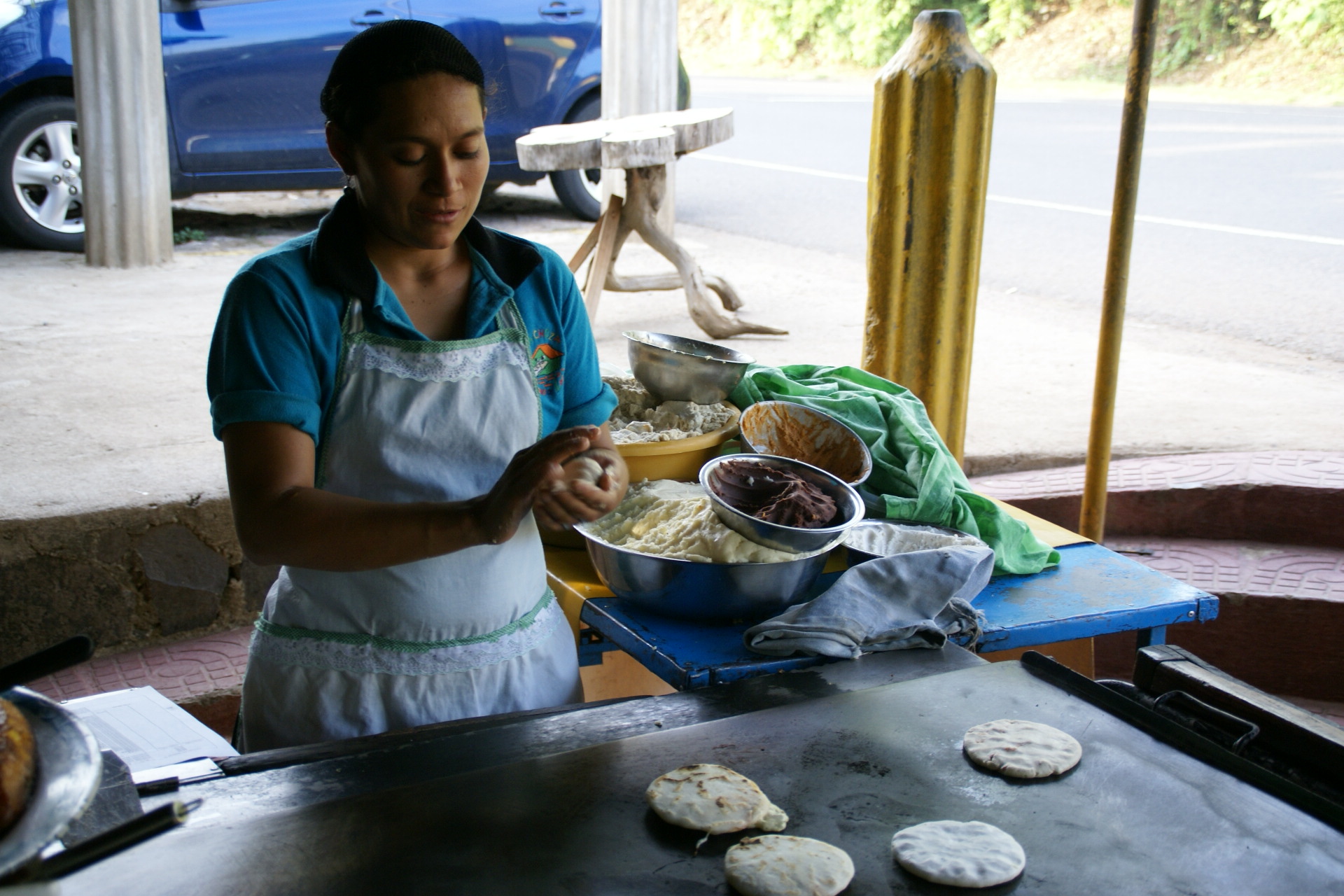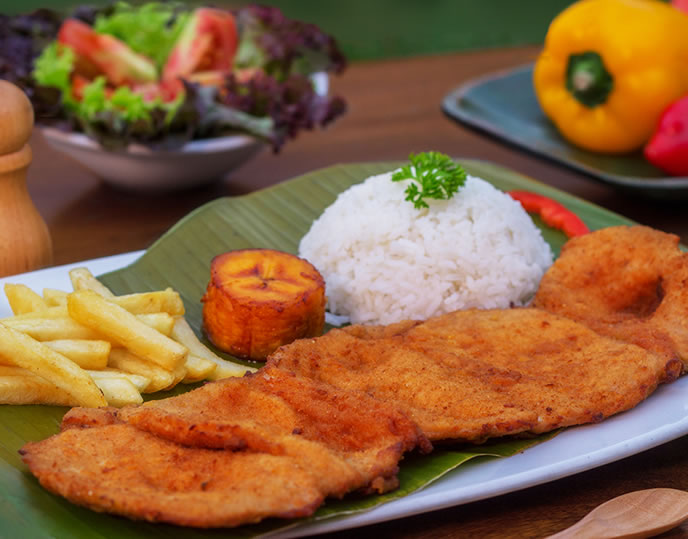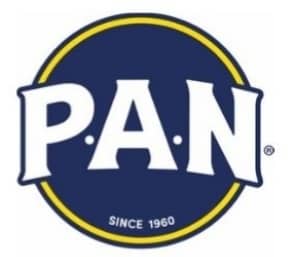|
Arepas
''Arepa'' () is a type of food made of ground maize dough stuffed with a filling, eaten in the northern region of South America since pre-Columbian times, and notable primarily in the cuisine of Colombia and Venezuela, but also present in the cuisines of Bolivia, Panama and other countries. It is commonly eaten in those countries and can be served with accompaniments such as cheese, ''cuajada'' (fresh cheese), various meats, chicken, avocado, or ''diablito'' (deviled ham spread). It can also be split to make sandwiches. Sizes, maize types, and added ingredients vary its preparation. It is similar to the Mexican '' gordita,'' the Salvadoran ''pupusa'', the Ecuadorian ''tortilla de maíz'' and the Panamanian ''tortilla'' or ''changa''. Origins The ''arepa'' is a pre-Columbian dish from the area that is now Colombia, Panama and Venezuela. Instruments used to make flour for the ''arepas'', and the clay slabs on which they were cooked, were often found at archaeological sites in th ... [...More Info...] [...Related Items...] OR: [Wikipedia] [Google] [Baidu] |
Pupusa
A pupusa is a thick griddle cake or flatbread from El Salvador and Honduras, made with cornmeal or rice flour, similar to the Colombian and Venezuelan arepa. In El Salvador, it has been declared the national dish and has a specific day to celebrate it. It is usually stuffed with one or more ingredients, which may include cheese (such as ''quesillo'' or cheese with ''loroco'' buds), ''chicharrón'', squash, or refried beans. It is typically accompanied by ''curtido'' (a spicy fermented cabbage slaw) and tomato salsa, and is traditionally eaten by hand. Etymology There is no definite explanation for the origin of the word. The word for pupusa in one of El Salvador's native languages, Nawat, is . It is possible that the word stems from the verb ''pupusawa'' which means 'to puff up', but there is no known current or historical use of this word within the communities. Origin El Salvador and Honduras both claim to be the birthplace of the pupusa. Salvadoran archeologist Roberto ... [...More Info...] [...Related Items...] OR: [Wikipedia] [Google] [Baidu] |
Venezuelan Cuisine
Venezuelan cuisine is influenced by its EuropeanKohnstamm, Thomas; Kohn, Beth"Venezuela."Lonely Planet. Accessed October 2011. (Italian, Spanish, Portuguese, and French), West African, and indigenous traditions. Venezuelan cuisine varies greatly from one region to another. Food staples include corn, rice, plantains, yams, beans and several meats. Potatoes, tomatoes, onions, eggplants, squashes, spinach and zucchini are also common side dishes in the Venezuelan diet. Ají dulce and papelón are found in most recipes. Worcestershire sauce is also used frequently in stews. Venezuela is also known for having a large variety of white cheese (queso blanco), usually named by geographical region. Main dishes Typical snacks Beverages * Beer * ''Chicha'' * ''Cocada'' – Coconut milkshake, found mostly in coastal areas. * Mango juice * Passion fruit juice * ''Malta'' – Non-alcoholic carbonated malt. * ''Papelón con limón'' * '' Ponche crema'' – Served especially during Chr ... [...More Info...] [...Related Items...] OR: [Wikipedia] [Google] [Baidu] |
Hallaca
Hallaca (, ; alt. spelling, ''hayaca'' and ''ayaca'') is a traditional dish from Venezuela that looks like a Tamale, tamal, though different in flavour, texture, ingredients and cultural significance. It consists of corn dough stuffed with a stew of beef, pork, or Chicken (food), chicken and other ingredients such as raisins, capers, and olives, fresh onion rings, red and green bell pepper slices. There are vegetarian hallacas, made with black beans or tofu. Hallacas are folded in Plantain (cooking)#Plantain leaves, plantain leaves, tied with strings, and boiled. The dish is traditionally served during the Christmas season and has several regional variants. It has been described as a national dish of Venezuela. Some speculate it originated from the Orinoquia. Characteristic of the hallaca is the delicate corn dough made with consommé or broth, and lard colored with annatto. Hallacas are also commonly eaten in eastern Cuba, Trinidad where it is called Pasteles, pastelle, and part ... [...More Info...] [...Related Items...] OR: [Wikipedia] [Google] [Baidu] |
Colombian Cuisine
Colombian cuisine is a compound of the culinary traditions of the six main regions within Colombia (Pacific, Amazonian, Andean, Orinoco, Caribbean, and Insular). Colombian cuisine varies regionally and is particularly influenced by Indigenous Colombian, Spanish, and African cuisines, with slight Arab influence in some regions. Furthermore, being one of the most biodiverse countries in the world, Colombia has one of the widest variety of available ingredients depending on the region. History of Colombian food Colombian food is a unique blend of indigenous and European traditions with a strong Afro-Caribbean influence. The two largest indigenous groups prior to European conquest were the Tairona, who lived along the Caribbean coast, and the Muisca, who lived in the highlands to the South. Arepas, made from ground corn, are one of the oldest cooked dishes in Colombian cuisine. It is believed that the name derives from the word for corn in the Chibcha languages. Arepas are a popul ... [...More Info...] [...Related Items...] OR: [Wikipedia] [Google] [Baidu] |
Harina PAN
The Harina P.A.N. (abbreviation for Producto Alimenticio Nacional. English: ''National Food Product''), is the first brand of boiled maize flour in Venezuela. The brand itself became a synecdoche, as even with other large competitors in the market, it is used as a noun to indicate any similar maize flour. Usage Harina PAN is used to make the maize flour dough also known as "masa de arepa" or "masarepa", which is used to make Venezuelan dishes such as arepas, hallacas, empanadas, bollos pelones, and several Colombian dishes. Harina PAN is commonly found in varieties made from white and yellow corn. It contains no additives or gluten and is considered suitable for those with restricted diets. History The traditional preparation of arepa flour is very labor-intensive, requiring soaking, dehusking, and drying maize before pounding it in a large mortar. Precooked arepa flour was invented in the 1950s by Dr. Luis Caballero Mejías, a Venezuelan engineer who used the profits fro ... [...More Info...] [...Related Items...] OR: [Wikipedia] [Google] [Baidu] |
European Colonization Of The Americas
During the Age of Discovery, a large scale European colonization of the Americas took place between about 1492 and 1800. Although the Norse had explored and colonized areas of the North Atlantic, colonizing Greenland and creating a short term settlement near the northern tip of Newfoundland circa 1000 CE, the later and more well-known wave by the European powers is what formally constitutes as beginning of colonization, involving the continents of North America and South America. During this time, several empires from Europe—primarily Britain, France, Spain, Portugal, Russia, the Netherlands and Sweden—began to explore and claim the land, natural resources and human capital of the Americas, resulting in the displacement, disestablishment, enslavement, and in many cases, genocide of the indigenous peoples, and the establishment of several settler colonial states. Some formerly European settler colonies—including New Mexico, Alaska, the Prairies or northern Grea ... [...More Info...] [...Related Items...] OR: [Wikipedia] [Google] [Baidu] |
Chicha
''Chicha'' is a fermented (alcoholic) or non-fermented beverage of Latin America, emerging from the Andes and Amazonia regions. In both the pre- and post-Spanish conquest periods, corn beer (''chicha de jora'') made from a variety of maize landraces has been the most common form of ''chicha''. However, ''chicha'' is also made from a variety of other cultigens and wild plants, including, among others, quinoa (''Chenopodium quinia''), kañiwa (''Chenopodium pallidicaule''), peanut, manioc (also called yuca or cassava), palm fruit, rice, potato, oca (''Oxalis tuberosa''), and chañar (''Geoffroea decorticans''). There are many regional variations of ''chicha''. In the Inca Empire, ''chicha'' had ceremonial and ritual uses. Etymology and related phrases The exact origin of the word ''chicha'' is debated. One belief is that the word ''chicha'' is of Taino origin and became a generic term used by the Spanish to define any and all fermented beverages brewed by indigenous peoples ... [...More Info...] [...Related Items...] OR: [Wikipedia] [Google] [Baidu] |
Atole
''Atole'' (, from Nahuatl '' ātōlli'' ), also known as ''atolli'' and ''atol de elote'', is a traditional hot corn- and masa-based beverage of Mexican origin. Chocolate ''atole'' is known as ''champurrado'' or ''atole''. It typically accompanies tamales, and is very popular during Day of the Dead (observed November 2) and ''Las Posadas'' (Christmas holiday season). In Mexico In Mexico, the drink typically includes'' masa ''(corn hominy flour), water, ''piloncillo'' (unrefined cane sugar), cinnamon, vanilla, and optional chocolate or fruit. The mixture is blended and heated before serving. ''Atole'' is made by toasting ''masa'' on a ''comal'' (griddle), then adding water that was boiled with cinnamon sticks. The resulting blends vary in texture, ranging from a porridge to a very thin, liquid consistency. ''Atole'' can also be prepared with rice, wheat, or oatmeal in place of masa. In northern Mexico, a variation is also made using ''pinole'' (sweetened toasted corn meal). ... [...More Info...] [...Related Items...] OR: [Wikipedia] [Google] [Baidu] |
Empanada
An empanada is a type of baked or fried turnover consisting of pastry and filling, common in Spanish, other Southern European, Latin American, and Iberian-influenced cultures around the world. The name comes from the Spanish (to bread, i.e., to coat with bread), and translates as 'breaded', that is, wrapped or coated in bread. They are made by folding dough over a filling, which may consist of meat, cheese, tomato, corn, or other ingredients, and then cooking the resulting turnover, either by baking or frying. Origins The origin of empanadas is unknown but they are thought to have originated in Galicia, a region in northwest Spain. A cookbook published in Catalan in 1520, ''Llibre del Coch'' by Robert de Nola, mentions empanadas filled with seafood in the recipes for Catalan, Italian, French, and Arabian food. By country and region Argentina Argentine empanadas are often served during parties and festivals as a starter or main course. Shops specialize in freshly m ... [...More Info...] [...Related Items...] OR: [Wikipedia] [Google] [Baidu] |
Tamale
A tamale, in Spanish tamal, is a traditional Mesoamerican dish made of masa, a dough made from nixtamalized corn, which is steamed in a corn husk or banana leaf. The wrapping can either be discarded prior to eating or used as a plate. Tamales can be filled with meats, cheeses, fruits, vegetables, herbs, chilies, or any preparation according to taste, and both the filling and the cooking liquid may be seasoned. ''Tamale'' is an anglicized version of the Spanish word (plural: ). comes from the Nahuatl . The English "tamale" is a back-formation of , with English speakers interpreting the ''-e-'' as part of the stem, rather than part of the plural suffix ''-es''. Origin Tamales originated in Mesoamerica as early as 8000 to 5000 BC. The preparation of tamales is likely to have spread from the indigenous cultures in Guatemala and Mexico to the rest of Latin America. According to archaeologists Karl Taube, William Saturno, and David Stuart, tamales may date from around ... [...More Info...] [...Related Items...] OR: [Wikipedia] [Google] [Baidu] |
Bollo
Bollo is a bun, popular in Latin America, made from corn, yuca or potato. Variations are eaten in Colombian cuisine, Cuban cuisine ( Tamal de maíz solamente ) and Panamanian cuisine. Corn and yuca bollos are an indigenous food of the Caribbean coast of Colombia and Panama, where they are boiled in leaves. This preparation is similar to the humita of the Andes, the hallaquita of Venezuela and the pamonha of Brazil. In Colombia, bollos are sold by street vendors along the Colombian coast, as well as in stores and supermarkets. They are primarily served for breakfast as an accompaniment with cheese. Panamanian bollo has been described as a type of tamale. File:Bollo Maimón-Salamanca.JPG, Bollo Maimón-Salamanca File:Bollo limpio.jpg, Bollo File:Bollos (Requena).jpg, Bollos Requena File:Bollo de mazorca.jpg, Bollo of Mazorca File:Bollo de angelito.jpg, Angelito bollo See also * List of maize dishes This is a list of maize dishes, in which maize (corn) is used as a primary ... [...More Info...] [...Related Items...] OR: [Wikipedia] [Google] [Baidu] |
Cornmeal
Cornmeal is a meal (coarse flour) or a cell membrane ground from dried corn. It is a common staple food, and is ground to coarse, medium, and fine consistencies, but not as fine as wheat flour can be.Herbst, Sharon, ''Food Lover's Companion'', Third Edition, Pg. 165, Barrons Educational Series Inc, 2001 In Mexico, very finely ground cornmeal is referred to as corn flour. When fine cornmeal is made from maize that has been soaked in an alkaline solution, e.g., limewater (a process known as nixtamalization), it is called masa harina (or masa flour), which is used for making arepas, tamales and tortillas. Boiled cornmeal is called polenta in Italy and is also a traditional dish and bread substitute in Romania. Types There are various types of cornmeal: *''Blue cornmeal'' is light blue or violet in color. It is ground from whole blue corn and has a sweet flavor. The cornmeal consists of dried corn kernels that have been ground into a fine or medium texture. *''Steel-ground yellow ... [...More Info...] [...Related Items...] OR: [Wikipedia] [Google] [Baidu] |



.jpg)




